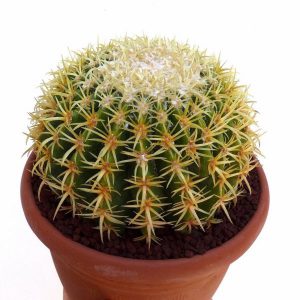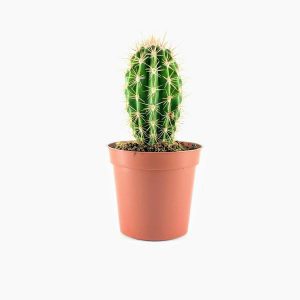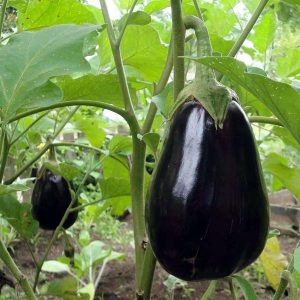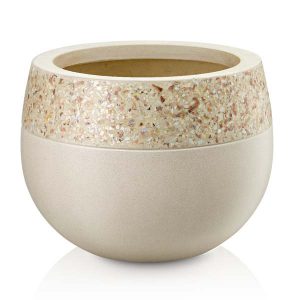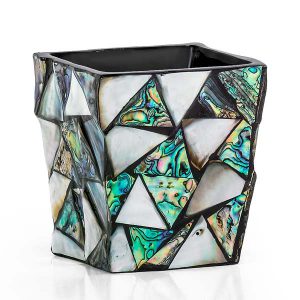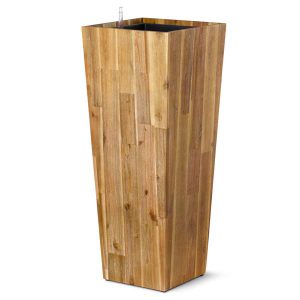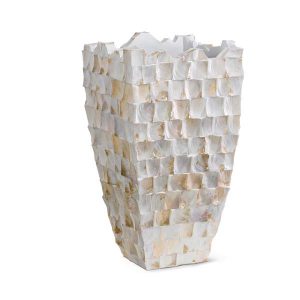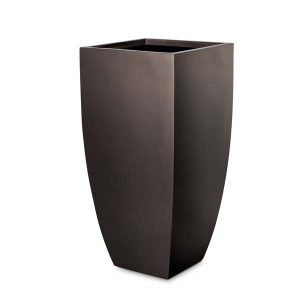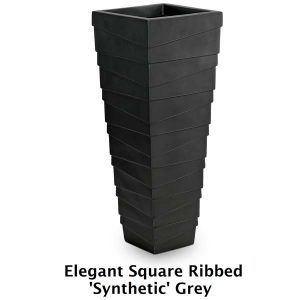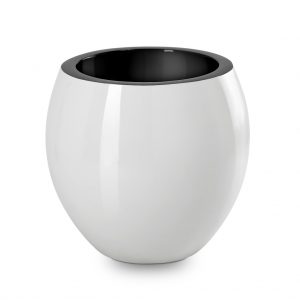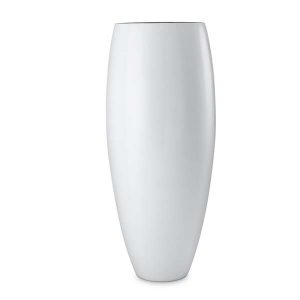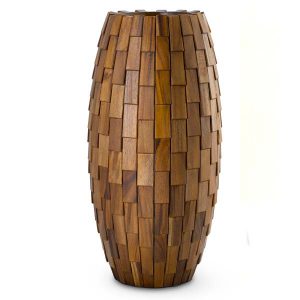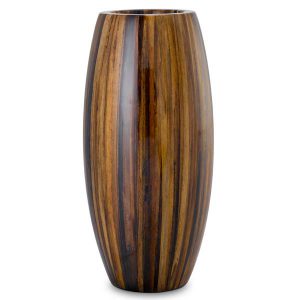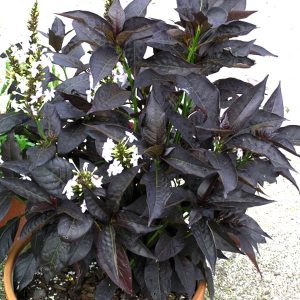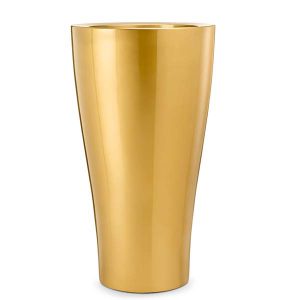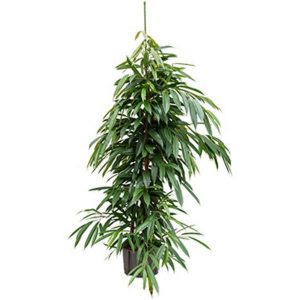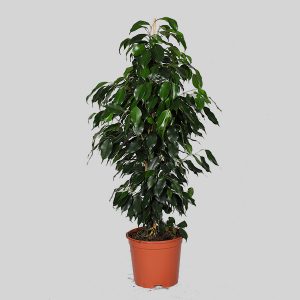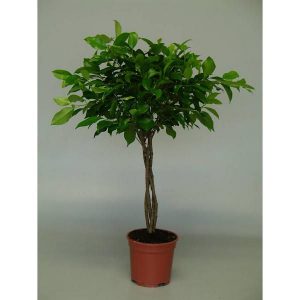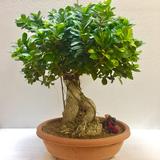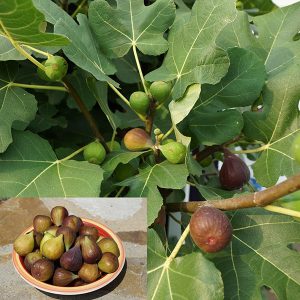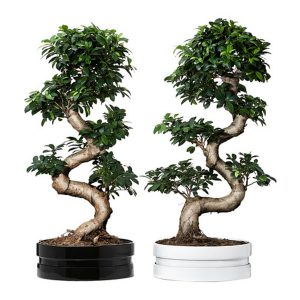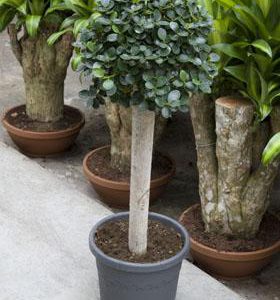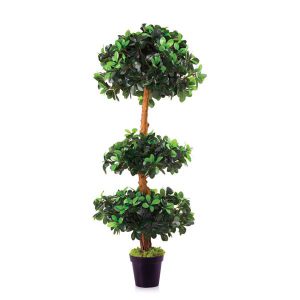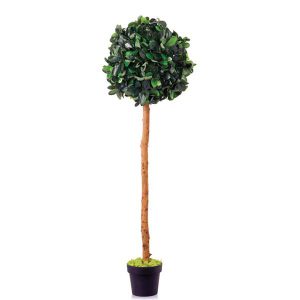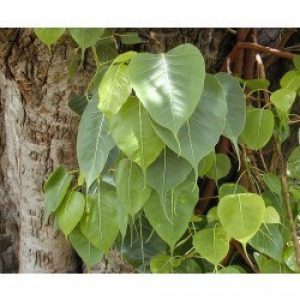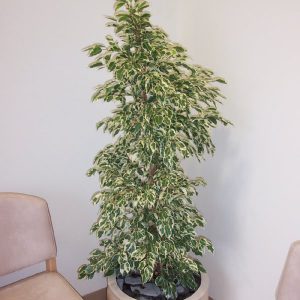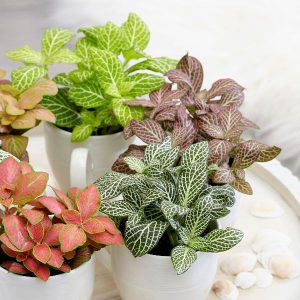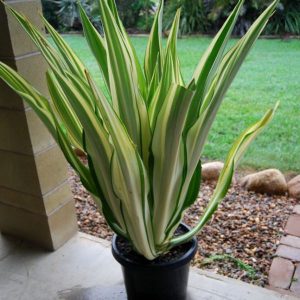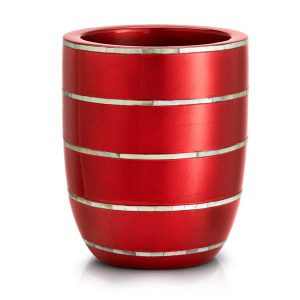Shop
Echino cactus Grusonil
Echinocactus grusonii, commonly known as mother-in-law’s cushion, stands out especially due to its golden spines, which form a beautiful contrast to the lush green of the cactus’ body. In addition, this cactus species is exceptionally robust and does not come with many requirements in terms of tending. Learn from these professional care instructions what exactly it is that your cactus needs.
AED 40.00Add to cart
Echinopsis-Cactus-Grusonil
It is one of the most popular cacti in cultivation and has increasingly become popular as an architectural accent plant in contemporary garden designs.[citation needed]
The cactus is considered easy and relatively fast growing in warmer climates around the world. The plants do have some basic requirements; an average minimum winter temperature of 12 °C (53.6 °F); and good drainage with less watering in winter.[2] Excess water in cool periods may lead to rot. Golden Barrels are hardy to about 15 °F (−8 °C) for brief periods.
Beyond Central Mexico, Echinocactus grusonii specimens may also be seen in collections of desert plants in many botanical gardens. In the UK it has gained the Royal Horticultural Society’s Award of Garden Merit
AED 45.00Read more
egg plant
The range of sizes, shapes, and colors of the heat-loving eggplant (Solanum melongena) tells the story of its enduring popularity. Native to India, where it grows wild, it has been cultivated in Southeast Asia for thousands of years.
Europe was introduced to the vegetable in the 8th century via the Moors, who brought it to Spain, Sicily, and southern France via North Africa. In the sunny, dry climate of the Mediterranean basin, eggplant found the warm growing conditions it prefers and soon found its way into the classic cuisines of the region.
AED 45.00Add to cart
eranthemum nigrum black kodia plant
The Eranthemum nigrum is also known as Black Kodia.
The subtropical climate is said to be the best for the growth of the plant.
The plant is grown widely as an ornamental plant.
The special feature of the plant is that it can grow anywhere. It has no specific requirements or conditions for growth.
The plant produces attractive white flowers from summer to fall.
AED 25.00Add to cart
Ficus Amstel king
- Care Instructions–
- Strong indirect light to some direct sun.
- Water thoroughly when the soil is dried out on the surface. A plant like this in a 14″(35cm) diameter pot can take up to 1 gallon, or almost 4 liters, of water when necessary. A plant in a 10″(25cm) pot can take as much a 2 quarts (almost 2 liters) of water when necessary. They like a good soak,
- Make sure the plant is well potted and if necessary add some potting soil. It is essential to make sure the soil is evenly packed especially around the inner edge so that it is watered evenly. Press the soil down firmly around the inner edge and make sure there is enough soil covering the top roots but not covering the bottom of the trunk.
- The leaves would like a dusting from time to time and an outdoor shower once or twice a year would be very helpful.
They can be pruned to stay in the space they have been given. Fertilize regularly for fullest growth.
AED 220.00Add to cart
Ficus benjamina
Ficus benjamina, commonly known as weeping fig, benjamin fig or ficus tree, and often sold in stores as just ficus, is a species of flowering plant in the family Moraceae, native to Asia and Australia. It is the official tree of Bangkok.
Plant Care
- Keep Ficus benjamina plants in large planting pots filled with a soil-based potting mix. …
- Place pots indoors in bright indirect light, and outdoors in full sun to part shade.
- Let the soil around the shrub dry out between waterings.
AED 165.00Add to cart
Ficus Benjamina ‘Real Feel’
Ficus Lyrata Multi Stem
Ficus is a genus of about 850 species of woody trees, shrubs, vines, and epiphytes, collectively known as ‘fig trees’. They are native throughout the tropics and are very commonly used as ornamental indoor plants. They are also, however, an important food resource for wildlife.
Ficus are a very diverse species with regard to scale, habit, leaf colour, size and shape. Figs are of considerable cultural importance throughout the tropics, both as objects of worship and for their many practical uses.
AED 1,200.00Add to cart
Ficus Benjamina Twisted
Ficus trees can maintain their tree-like shape regardless of their size, so this makes them ideal for bonsais or for massive houseplants in large spaces. Their leaves can be either dark green or variegated. In recent years, some imaginative nurseries have started to take advantage of their pliable trunks to braid or twist the plants into different forms.
Plant the ficus in a well-draining potting mix. Purchase a loamy soil with added vermiculite or perlite for drainage, or mix your own. Use 3 parts loam 1 part peat and 1 part sand for a well-draining mixture. Plant in a deep pot with drainage holes so the water can run out. Place the ficus near a window in a room that gets bright light in the summer with more moderate light in the winter. Turn the plant occasionally so all the growth does not occur on one side.
Water weekly during the summer with room-temperature water. Add water until it drains from the bottom of the pot. Discard the excess water if it flows into a container. Adjust the watering for your particular plant. Allow the soil to dry slightly between waterings. If the leaves turn yellow and begin to drop, you may need to increase or decrease the amount of water. Check the root ball. If the roots are soggy water the plant less often. If they are dry, increase watering. Humidity and light levels affect the amount of water needed.
AED 600.00Add to cart
Ficus bonsai Ginseng
Ginseng Ficus is a low-maintenance bonsai that can be grown indoors or outdoors. Of course if you live in an area where temperatures drop below 68 degrees, your little tree should be grown indoors. This type of bonsai can survive without direct sunlight, but you will have a much happier and healthier tree if you place it near a window or an area that receives a lot of sunlight.
AED 85.00Add to cart
ficus carica (fig)
Ficus carica, commonly called common fig, is a deciduous shrub (to 10-15’ tall) or small tree (to 15-30’ tall). It is noted for its spreading habit, attractive foliage and edible fruit. Old trees with smooth silver-gray bark (sometime gnarled with age) are ornamentally attractive. Large, palmate, hairy, 3-5 lobed leaves (to 10” long) are rough dark green above and smooth light green beneath. Non-showy greenish flowers form in spring inside hollow receptacles near the branch growing tips. The fruit (edible fig) develops within each receptacle. The main fruit crop ripens in late summer or fall on new wood. In some areas, a lesser crop may appear in spring on new wood. Species plants as well as most fig cultivars are parthenocarpic (fruits develop without cross pollination).
Genus name comes from the Latin name for Ficus carica the edible fig.
Specific epithet refers to Caria, a district in Asia Minor known for growing figs.
AED 150.00Add to cart
Ficus Lyrata
Ficus lyrata, commonly known as the fiddle-leaf fig, is a species of flowering plant in the mulberry and fig family Moraceae. It is native to western Africa, from Cameroon west to Sierra Leone, where it grows in lowland tropical rainforest
Plant Care
- Light – Needs Bright, Filtered Light. …
- Watering – Keep soil evenly moist at all times. …
- Fertilizer – Feed bi-weekly with a weak green plant liquid solution during the growing season.
- Repotting -Change dirt and transplant to a a larger pot annually.
AED 125.00Add to cart
Ficus Lyrata Multi Stem ‘Real Feel’
Ficus Lyrata Multi Stem
Ficus is a genus of about 850 species of woody trees, shrubs, vines, and epiphytes, collectively known as ‘fig trees’. They are native throughout the tropics and are very commonly used as ornamental indoor plants. They are also, however, an important food resource for wildlife.
Ficus are a very diverse species with regard to scale, habit, leaf colour, size and shape. Figs are of considerable cultural importance throughout the tropics, both as objects of worship and for their many practical uses.
AED 1,200.00Add to cart
Ficus Microcarpa Compacta
Ficus microcarpa is native in the range from Sri Lanka to India, Taiwan, the Malay Archipelago, the Ryukyu Islands, Australia, and New Caledonia. It is a rapidly-growing, rounded, broad-headed, evergreen shrub or tree that can reach 15m (49 feet) or more in height with an equal spread. The smooth, light grey trunk is quite striking, can grow to around 1m (3.3 feet) in diameter, and it firmly supports the massively spreading canopy.
The glossy, dark green, leathery leaves are densely clothed on large, somewhat weeping branches. New growth, produced all year long, is a light rose to chartreuse color, giving the tree a lovely two-toned effect.
AED 950.00Add to cart
Ficus Open Braid ‘Real Feel’
Ficus Open Braid
Ficus is a genus of about 850 species of woody trees, shrubs, vines, and epiphytes, collectively known as ‘fig trees’. They are native throughout the tropics and are very commonly used as ornamental indoor plants. They are also, however, an important food resource for wildlife.
Ficus are a very diverse species with regard to scale, habit, leaf colour, size and shape. Figs are of considerable cultural importance throughout the tropics, both as objects of worship and for their many practical uses.
AED 1,200.00Add to cart
ficus panda
Ficus (genus Ficus), a group of about 900 species of trees, shrubs, and vines, commonly called figs. Native primarily to tropical areas of East Asia, they are distributed throughout the world’s tropics. Many are tall forest trees that are buttressed by great spreading roots; others are planted as ornamentals.
The always popular ficus tree is a member of the fig family and perfect for caring for as a houseplant. There are several varieties of this plant that are grown as houseplants. Among these are the ficus benjamina or weeping fig, the ficus lyrata or fiddle head fig, and the ficus elastica decora or rubber tree. The Bodhi tree, under which the Buddha achieved enlightenment, is believed by many to have been a ficus religiosa. The most popular as an indoor tree is the ficus benjamina.
AED 230.00Add to cart
Ficus Panda 3 Tier ‘Real Feel’
Ficus Panda 3 Tier ‘Real Feel’
Ficus is a genus of about 850 species of woody trees, shrubs, vines, and epiphytes, collectively known as ‘fig trees’. They are native throughout the tropics and are very commonly used as ornamental indoor plants. They are also, however, an important food resource for wildlife.
Ficus are a very diverse species with regard to scale, habit, leaf colour, size and shape. Figs are of considerable cultural importance throughout the tropics, both as objects of worship and for their many practical uses.
AED 1,400.00Add to cart
Ficus Panda Crown Ball ‘Real Feel’
Ficus Panda Crown Ball
Ficus is a genus of about 850 species of woody trees, shrubs, vines, and epiphytes, collectively known as ‘fig trees’. They are native throughout the tropics and are very commonly used as ornamental indoor plants. They are also, however, an important food resource for wildlife.
Ficus are a very diverse species with regard to scale, habit, leaf colour, size and shape. Figs are of considerable cultural importance throughout the tropics, both as objects of worship and for their many practical uses.
AED 700.00Add to cart
ficus religiosa
Grow bodhi trees outdoors in the garden in areas with little or no frost. The National Taiwan University reports that bodhi trees will not survive minimum winter temperatures below 50 degrees Fahrenheit while the Missouri Botanical Garden website states that they are hardy down to 30 degrees F.
AED 0.00Read more
Ficus S Shape ‘Real Feel’
Ficus S Shape ‘Real Feel’
Ficus is a genus of about 850 species of woody trees, shrubs, vines, and epiphytes, collectively known as ‘fig trees’. They are native throughout the tropics and are very commonly used as ornamental indoor plants. They are also, however, an important food resource for wildlife.
Ficus are a very diverse species with regard to scale, habit, leaf colour, size and shape. Figs are of considerable cultural importance throughout the tropics, both as objects of worship and for their many practical uses.
AED 1,200.00Add to cart
Ficus Starlight
Description for Ficus Starlight. Ficus is a pan-tropical genus of trees, shrubs and vines occupying a wide variety of ecological niches; most are evergreen, but some deciduous species are endemic to areas outside of the tropics and to higher elevations.
Under glass grow in loam-based potting compost with added fine bark chippings in full or filtered light. When in growth water moderately and apply a nitrogen rich fertiliser monthly. Keep just moist in winter. Plants benefit from regular misting and from being stood on a pebble tray, particularly in a warm dry atmosphere. Their main requirement is an even temperature, in winter not below 13°C and without the sharp fluctuations found in so many houses. Avoid draughty situations and keep them away from heater fumes
AED 170.00Add to cart
Fox tail Grass Brown ‘Real Feel’
Foxtail Grass Brown
Graminoids (grasses) are the dominant vegetation in many habitats, including grassland, salt-marsh, reed swamp and steppes. They also occur as a smaller part of the vegetation in almost every other terrestrial habitat. Bamboos are a group of woody perennial evergreen plants in the true grass family Poaceae. There are 91 genera and about 1,000 species of bamboo alone! The diversity and importance of the grasses, which also includes rice, maize wheat, oats and barley (a basic food source) is staggering.
AED 160.00Add to cart
Fox tail Grass Green ‘Real Feel’
Foxtail Grass Green
Graminoids (grasses) are the dominant vegetation in many habitats, including grassland, salt-marsh, reed swamp and steppes. They also occur as a smaller part of the vegetation in almost every other terrestrial habitat. Bamboos are a group of woody perennial evergreen plants in the true grass family Poaceae. There are 91 genera and about 1,000 species of bamboo alone! The diversity and importance of the grasses, which also includes rice, maize wheat, oats and barley (a basic food source) is staggering.
AED 160.00Add to cart
furcraea foctida
Growing F. foetida is as simple a matter as keeping its soil drained and making sure it receives an adequate amount of sunlight. These plants are drought-resistant and need to be watered only infrequently—in the wild, they often grow on rocks or cliffs—and they prefer full sun. If you’re growing them in pots rather than your garden, make sure the soil stays fairly dry and repot if necessary.
AED 240.00Add to cart

